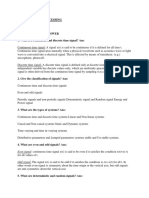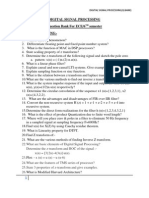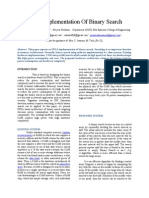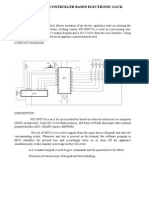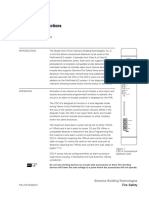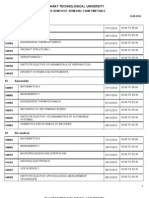0 ratings0% found this document useful (0 votes)
163 viewsData Flow Modelling
- Data flow modeling uses continuous assignments and operators to design hardware at a register-transfer level of abstraction by describing the flow of data between registers. It uses assignment statements to continuously assign values to nets based on changes to operands. Some key aspects covered include continuous assignment syntax, implicit assignments, adding delays, and examples of data flow models for common components like adders, multiplexers, and counters.
Uploaded by
Giri ReddyCopyright
© © All Rights Reserved
Available Formats
Download as PPT, PDF, TXT or read online on Scribd
0 ratings0% found this document useful (0 votes)
163 viewsData Flow Modelling
- Data flow modeling uses continuous assignments and operators to design hardware at a register-transfer level of abstraction by describing the flow of data between registers. It uses assignment statements to continuously assign values to nets based on changes to operands. Some key aspects covered include continuous assignment syntax, implicit assignments, adding delays, and examples of data flow models for common components like adders, multiplexers, and counters.
Uploaded by
Giri ReddyCopyright
© © All Rights Reserved
Available Formats
Download as PPT, PDF, TXT or read online on Scribd
You are on page 1/ 23
Data Flow Modeling
For complex designs.
Functional Implementation at a higher level
of abstraction.
Design in terms of the data flow between
registers.
RTL design for maximum flexibility.
(Register Transfer Level->dataflow modeling
+ behavioral modeling)
Dataflow modeling uses a number of operators that act
on operands to produce desired results.
Dataflow modeling uses continuous assignments and the
keyword assign.
A continuous assignment is a statement that assigns a
value to a net.
Continuous Assignments
Syntax:
assign #del <id> = <expr>;
Where to write them:
inside a module
outside procedures
Properties:
they all execute in parallel
are order independent
are continuously active
optional net type !!
Continuous assignment
o
Continuous assignment starts with keyword assign.
The left hand side of a continuous assignment command must be
a net-type signal.
The operands on the right-hand side can be registers or nets or
function calls.
Evaluation as soon as one of the right-hand-side operands changes
and the value is assigned to the left-hand-side net.
Ex.
a
b
c
x
AND
OR
module cir1 (o, a, b, c);
output o;
input a, b, c;
wire x;
assign x = a & b;
assign o = x | c;
endmodule
module cir1 (o, a, b, c);
output o;
input a, b, c;
wire x = a & b;
assign o = x | c;
endmodule
OR
Implicit Continuous Assignment
module cir1 (o, a, b, c);
output o;
input a, b, c;
assign x = a & b;
assign o = x | c;
endmodule
OR
Implicit Net Declaration
Regular Assignment Delay
assign #10 out = in1 & in2; // Delay in a continuous assign.
Implicit Continuous Assignment Delay
wire #10 out = in1 & in2;
same as wire out;
assign #10 out = in1 & in2;
Net Declaration Delay
wire # 10 out;
assign out = in1 & in2;
same as wire out;
assign #10 out = in1 & in2;
Adding delay to continuous assignment
Expressions, Operators, and Operands
Operators Operator Symbols Precedence
Unary + - ! ~ Highest precedence
Multiply, Divide, Modulus * / %
Add, Subtract + -
Shift << >>
Relational < <= > >=
Equality == != === !==
Reduction &, ~&
^ ^~
|, ~|
Logical &&
||
Conditional ?: Lowest precedence
Arithmetic operators
Available operators: +, -, *, /, % (modulo)
Arithmetic operators treat register operands as unsigned values
Example:
integer A;
A = -12;
A/4 -3
reg [7:0] A;
A = -12;
A/4 61
Relation and equality operators
Available relational operators: <, <=, >, >=
If any bit of an operand is X or Z, the result will be X
Available equality operators: ===, !==, ==, !=
= = =, != = : case equality (inequality). X and Z values are considered
in comparison
= =, != : logic equality (inequality). If any bit of an operand is
X or Z, the result will be X
X X 0 1 0XX0 0XX0
X X 1 0 0XX0 0110
0 1 0 1 0110 0110
!= == !== === Right Op. Left Op.
Example
Logic operators
Logic operators:
&& (logic and), || (logic or), ! (logic not)
Bit-wise logic operators:
& (and), | (or), ~ (not), ^ (xor), ~^ (xnor)
Reducation operators:
& (and), ~& (nand), | (or), ~| (nor), ^ (xor), ~^ (xnor)
0
^A
1 0 1 1 0 1010
~^A ~|A |A ~&A &A Operand A
1001
A^B
0110 0101 1011 0010 0011 1010
A~^B ~A A|B A&B Operand B Operand A
1 0 1 0 00 1010
0
!B
0 1 1 011 1010
!A A|B A&B Operand B Operand A
Shift operators
<< : shift left
>> : shift right
reg [3:0] A;
1 1 0 1 A << 2 0 1 0 0
zeros are moved in from the right end
reg [3:0] A;
1 1 0 1 A >> 2 0 0 1 1
Concatenation operators
Example
reg [7:0] A, B, Data;
reg c;
A = 10101101; B= 00110011;
c = 0;
Data = {A[3:0], B[7:6], c, c}; // Data = 11010000
1 1 0 1 0 0 0 0 Data
A[3:0] B[7:6]
c c
Replication Operator
For repetitive concatenation of the same number.
A replication constant specifies how many times to replicate
the number inside the brackets ( { } ).
A = 1'b1; B = 2'b00; C = 2'b10; D = 3'b110;
Y = { 4{A} } // Result Y is 4'b1111
Y = { 4{A} , 2{B} } // Result Y is 8'b11110000
Y = { 4{A} , 2{B} , C } // Result Y is 10'b1111000010
Conditional Operator
The conditional operator(?:) is a ternary operator.
Usage: condition_expr ? true_expr : false_expr ;
Ex.2-to-1mux
assign out = control ? in1 : in0;
If the condition expression is x then true_expr and false_expr
are evaluated.
Results are compared, bit by bit, to return for each bit position
an x if the bits are different and the value of the bits if they are
the same.
EXAMPLES
//Dataflow description of 4-bit adder
module binary_adder (A,B,Cin,SUM,Cout);
input [3:0] A,B;
input Cin;
output [3:0] SUM;
output Cout;
assign {Cout,SUM} = A + B + Cin;
endmodule
//Dataflow description of 2-to-1-line multiplexer
module mux2_1_df (A,B,select,OUT);
input A,B,select;
output OUT;
assign OUT = select ? A : B; //(~select & B) | (select & A);
endmodule
4_1 mux?
Dataflow description of a 2-to-4-line decoder
module decoder_df (A,B,D);
input A,B;
output [3:0] D;
assign D[0] = ~A & ~B,
D[1] = ~A & B,
D[2] = A & ~B,
D[3] = A & B;
endmodule
assign D= (4b0001) << A; //input[1:0]A
A B D3 D2 D1 D0
0 0 0 0 0 1
0 1 0 0 1 0
1 0 0 1 0 0
1 1 1 0 0 0
Negative Edge-Triggered
D-flip flop with Clear
4-bit Ripple Carry Counter
module edge_dff(q, qbar, d, clk, clear);
output q,qbar;
input d, clk, clear;
wire s, sbar, r, rbar,cbar;
assign cbar = ~clear;
assign sbar = ~(rbar & s),
s = ~(sbar & cbar & ~clk),
r = ~(rbar & ~clk & s),
rbar = ~(r & cbar & d);
assign q = ~(s & qbar),
qbar = ~(q & r & cbar);
endmodule
module T_FF(q, clk, clear);
output q;
input clk, clear;
edge_dff ff1(q, ,~q, clk, clear);
endmodule
module counter (Q , clock, clear);
output [3:0] Q;
input clock, clear;
T_FF tff0(Q[0], clock, clear);
T_FF tff1(Q[1], Q[0], clear);
T_FF tff2(Q[2], Q[1], clear);
T_FF tff3(Q[3], Q[2], clear);
endmodule
module stimulus;
reg CLOCK, CLEAR;
wire [3:0] Q;
counter c1(Q, CLOCK, CLEAR);
initial $monitor($time, " Count Q = %b Clear= %b", Q[3:0],CLEAR);
initial
begin
CLEAR = 1'b1;
#34 CLEAR = 1'b0;
#200 CLEAR = 1'b1;
#50 CLEAR = 1'b0;
end
Initial
begin
CLOCK = 1'b0;
forever #10 CLOCK = ~CLOCK;
end
initial
begin
#400 $finish;
end
endmodule
0 Count Q = 0000 Clear= 1
34 Count Q = 0000 Clear= 0
40 Count Q = 0001 Clear= 0
60 Count Q = 0010 Clear= 0
80 Count Q = 0011 Clear= 0
100 Count Q = 0100 Clear= 0
120 Count Q = 0101 Clear= 0
140 Count Q = 0110 Clear= 0
160 Count Q = 0111 Clear= 0
180 Count Q = 1000 Clear= 0
200 Count Q = 1001 Clear= 0
220 Count Q = 1010 Clear= 0
234 Count Q = 0000 Clear= 1
284 Count Q = 0000 Clear= 0
300 Count Q = 0001 Clear= 0
320 Count Q = 0010 Clear= 0
340 Count Q = 0011 Clear= 0
360 Count Q = 0100 Clear= 0
380 Count Q = 0101 Clear= 0
output of the simulation
You might also like
- D. Text Based: The Time Period For The Clock #10 Clock ClockNo ratings yetD. Text Based: The Time Period For The Clock #10 Clock Clock5 pages
- Assignment 7 System Design Through VERILOG - Unit 8 - Week 7 - Test BenchesNo ratings yetAssignment 7 System Design Through VERILOG - Unit 8 - Week 7 - Test Benches4 pages
- GTU PHD Core Syllabus CMOS Analog Circuit DesignNo ratings yetGTU PHD Core Syllabus CMOS Analog Circuit Design1 page
- WWW - Universityquestions.in: Department of Electronics and Communication EngineeringNo ratings yetWWW - Universityquestions.in: Department of Electronics and Communication Engineering10 pages
- EX. NO: 1 Date: Implementation of Basic Logic Gates in FpgaNo ratings yetEX. NO: 1 Date: Implementation of Basic Logic Gates in Fpga66 pages
- Basics of Digital System Design For Beginners ISBN:978-81-957614-4-9No ratings yetBasics of Digital System Design For Beginners ISBN:978-81-957614-4-98 pages
- Small-Scale Multipath Measurements Lecture NotesNo ratings yetSmall-Scale Multipath Measurements Lecture Notes6 pages
- Unit 1 - Hardware Description LanguagesNo ratings yetUnit 1 - Hardware Description Languages24 pages
- Experiment No:01 Full Adder: Aim AlgorithmNo ratings yetExperiment No:01 Full Adder: Aim Algorithm25 pages
- Quote of The Day: Electronics Interview Questions On Communication SystemNo ratings yetQuote of The Day: Electronics Interview Questions On Communication System10 pages
- The Embedded Design Life Cycle: - Product Specification - Hardware/software Partitioning - Hardware/software IntegrationNo ratings yetThe Embedded Design Life Cycle: - Product Specification - Hardware/software Partitioning - Hardware/software Integration18 pages
- Questions From 10 Question Papers: Module 1: Number Systems and CodesNo ratings yetQuestions From 10 Question Papers: Module 1: Number Systems and Codes4 pages
- Simulation of Some Power System, Control System and Power Electronics Case Studies Using Matlab and PowerWorld SimulatorFrom EverandSimulation of Some Power System, Control System and Power Electronics Case Studies Using Matlab and PowerWorld SimulatorNo ratings yet
- Transmission Lines in Digital and Analog Electronic Systems: Signal Integrity and CrosstalkFrom EverandTransmission Lines in Digital and Analog Electronic Systems: Signal Integrity and CrosstalkNo ratings yet
- EE642A: Antenna Analysis and Synthesis: Arh@iitk - Ac.inNo ratings yetEE642A: Antenna Analysis and Synthesis: Arh@iitk - Ac.in17 pages
- Fiber-Optic Bus-Oriented Single-Hop Interconnections Among Multi-Transceiver StationsNo ratings yetFiber-Optic Bus-Oriented Single-Hop Interconnections Among Multi-Transceiver Stations8 pages
- Robust Super-Resolution: Presented By: Assam DaitchiNo ratings yetRobust Super-Resolution: Presented By: Assam Daitchi47 pages
- Thermo Scientific 48iq: Carbon Monoxide Analyzer-Gas Filter CorrelationNo ratings yetThermo Scientific 48iq: Carbon Monoxide Analyzer-Gas Filter Correlation2 pages
- Installation Instructions Model CDC-4: Conventional Detector CardNo ratings yetInstallation Instructions Model CDC-4: Conventional Detector Card12 pages
- Course Schedule: SEDA Malaysia Grid-Connected Photovoltaic (PV) Systems Design CourseNo ratings yetCourse Schedule: SEDA Malaysia Grid-Connected Photovoltaic (PV) Systems Design Course3 pages
- Bur 87634742NA - J.C.M SV212, SV216 Tier 3No ratings yetBur 87634742NA - J.C.M SV212, SV216 Tier 348 pages
- Ionic Equilibrium - JEE Main 2022 Chapter Wise Questions by MathonGoNo ratings yetIonic Equilibrium - JEE Main 2022 Chapter Wise Questions by MathonGo7 pages
- The Design and Construction of A DDS Based Waveform GeneratorNo ratings yetThe Design and Construction of A DDS Based Waveform Generator12 pages
- Gujarat Technological University: Be 4'Th Semester - Remedial Exam TimetableNo ratings yetGujarat Technological University: Be 4'Th Semester - Remedial Exam Timetable10 pages
- Protection Techniques With Renewable Resources and Smart Grids-A Survey 2015 PDFNo ratings yetProtection Techniques With Renewable Resources and Smart Grids-A Survey 2015 PDF23 pages
- Theory Date Sheet of Dae 1st 2nd 3rd s2024No ratings yetTheory Date Sheet of Dae 1st 2nd 3rd s2024126 pages
- 1N4728 (A) - 1N4764 (A) : 1 Watt Zener DiodesNo ratings yet1N4728 (A) - 1N4764 (A) : 1 Watt Zener Diodes4 pages
- DIY Battery Pack For Quadcopter (Recycling 18650 Cells From A Laptop)No ratings yetDIY Battery Pack For Quadcopter (Recycling 18650 Cells From A Laptop)16 pages
- Independent University, Bangladesh (IUB) : Experiment No: 04 Experiment Name: Parallel DC Circuit ObjectiveNo ratings yetIndependent University, Bangladesh (IUB) : Experiment No: 04 Experiment Name: Parallel DC Circuit Objective4 pages
- D. Text Based: The Time Period For The Clock #10 Clock ClockD. Text Based: The Time Period For The Clock #10 Clock Clock
- Assignment 7 System Design Through VERILOG - Unit 8 - Week 7 - Test BenchesAssignment 7 System Design Through VERILOG - Unit 8 - Week 7 - Test Benches
- WWW - Universityquestions.in: Department of Electronics and Communication EngineeringWWW - Universityquestions.in: Department of Electronics and Communication Engineering
- EX. NO: 1 Date: Implementation of Basic Logic Gates in FpgaEX. NO: 1 Date: Implementation of Basic Logic Gates in Fpga
- Basics of Digital System Design For Beginners ISBN:978-81-957614-4-9Basics of Digital System Design For Beginners ISBN:978-81-957614-4-9
- Quote of The Day: Electronics Interview Questions On Communication SystemQuote of The Day: Electronics Interview Questions On Communication System
- The Embedded Design Life Cycle: - Product Specification - Hardware/software Partitioning - Hardware/software IntegrationThe Embedded Design Life Cycle: - Product Specification - Hardware/software Partitioning - Hardware/software Integration
- Questions From 10 Question Papers: Module 1: Number Systems and CodesQuestions From 10 Question Papers: Module 1: Number Systems and Codes
- Simulation of Some Power System, Control System and Power Electronics Case Studies Using Matlab and PowerWorld SimulatorFrom EverandSimulation of Some Power System, Control System and Power Electronics Case Studies Using Matlab and PowerWorld Simulator
- Transmission Lines in Digital and Analog Electronic Systems: Signal Integrity and CrosstalkFrom EverandTransmission Lines in Digital and Analog Electronic Systems: Signal Integrity and Crosstalk
- EE642A: Antenna Analysis and Synthesis: Arh@iitk - Ac.inEE642A: Antenna Analysis and Synthesis: Arh@iitk - Ac.in
- Fiber-Optic Bus-Oriented Single-Hop Interconnections Among Multi-Transceiver StationsFiber-Optic Bus-Oriented Single-Hop Interconnections Among Multi-Transceiver Stations
- Robust Super-Resolution: Presented By: Assam DaitchiRobust Super-Resolution: Presented By: Assam Daitchi
- Thermo Scientific 48iq: Carbon Monoxide Analyzer-Gas Filter CorrelationThermo Scientific 48iq: Carbon Monoxide Analyzer-Gas Filter Correlation
- Installation Instructions Model CDC-4: Conventional Detector CardInstallation Instructions Model CDC-4: Conventional Detector Card
- Course Schedule: SEDA Malaysia Grid-Connected Photovoltaic (PV) Systems Design CourseCourse Schedule: SEDA Malaysia Grid-Connected Photovoltaic (PV) Systems Design Course
- Ionic Equilibrium - JEE Main 2022 Chapter Wise Questions by MathonGoIonic Equilibrium - JEE Main 2022 Chapter Wise Questions by MathonGo
- The Design and Construction of A DDS Based Waveform GeneratorThe Design and Construction of A DDS Based Waveform Generator
- Gujarat Technological University: Be 4'Th Semester - Remedial Exam TimetableGujarat Technological University: Be 4'Th Semester - Remedial Exam Timetable
- Protection Techniques With Renewable Resources and Smart Grids-A Survey 2015 PDFProtection Techniques With Renewable Resources and Smart Grids-A Survey 2015 PDF
- DIY Battery Pack For Quadcopter (Recycling 18650 Cells From A Laptop)DIY Battery Pack For Quadcopter (Recycling 18650 Cells From A Laptop)
- Independent University, Bangladesh (IUB) : Experiment No: 04 Experiment Name: Parallel DC Circuit ObjectiveIndependent University, Bangladesh (IUB) : Experiment No: 04 Experiment Name: Parallel DC Circuit Objective





